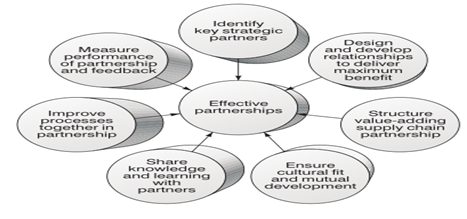Effective Partnerships
Customers and suppliers both have an effective partnerships. Moreover, they have the same goal of satisfying the end user. And, Supplier partnership is the discipline of strategically planning and managing all interactions with third party organizations that supply good and/or services to organization. And it also maximize value of those interactions.
Above all, there is a need to create closer, more collaborative relationships with key suppliers in order to uncover and realize new value, and reduce risk.
Most importantly, a key part of effective partnerships is identifying with whom those key strategic partnerships will be formed. Whether it is working with key suppliers to deliver materials or components to the required quality. Moreover, it also includes,
- Firstly, plan and costs
- Secondly, the supply of information technology
- Then, transport
- Broadcasting or consultancy services
- Lastly, the quality of partnerships.
This is the Effective Partnerships chart,
Moreover, there are various ways of ensuring the effective partnership processes work well for an organization. And another key aspect of successful partnerships is good communications and exchange of information. Above all, this supports learning between two organizations and often leads to innovative solutions to problems.
Requirements of Supplier Partnerships
Successful supplier partnerships require commitment and continual nurturing as the effective partnerships. Regarding this, there are following points which are,
- Supplier people should meet with buyers beyond those in the purchasing office. Moreover, It is particularly important for them to meet with people who actually use their products for improvements.
- The price-only approach to buyer –supplier negotiations should be eliminated. Above all, Product features, quality, and delivery concerns should also be part of the negotiations to achieve the optimum deal.
- The quality of supplier products should be guaranteed by the supplier’s quality processes. Moreover, the buyer should have no need to inspect the supplier’s products.
- Both partners should be capable of sharing information electronically so that the relationship is not inhibited by paperwork. Electronic data exchange is important for successful Just in Time (JIT).
- The supplier should be able to practice just-in time (JIT). And, buyers should not need to maintain inventories.
Impacts of quality improvement
- Firslty, Customers and society get benefited by quality of organization products by enhancing customer satisfaction and delight. Moreover, the improved quality products and organized services make the society and customers more dependent on them. Above all, improved quality increases employment and prosperity in the society.
- Companies’ performance – Through quality improvement there will be spectacular growth in the net profits of the organization. Quality facilitates the reduction of waste which results in increased quality output and reduced use of inventory.
- Nation’s economy – The national economy becomes stronger and stronger as a result of exports and earning foreign exchange brought by quality. Quality helps in raising the living standards of all the people in the country and helps in improving science and technology.
Role Of Supplier Partnership
Timeliness
- Suppliers should ensured that they deliver the required inputs on time. And in return the customer should pay for the supplied inputs on time.
Information
- Customer is responsible for providing the supplier with clear and sufficient information of requirements. So that the supplier can know what to produce.
Product evaluation
- Customer and the supplier should decide the method to evaluate the quality of the products or services for the satisfaction of both parties.
Monitor customer complaints
- When dealing with business transactions, both the customer and the supplier always have the best interest of the end user in mind. Moreover, having a complaints handling system in place will help to pick up trends related to your products.
Awareness of product liability laws
- Both customer and supplier should ensure that their products follow the safety standards.
Ensure necessary tests are done –
- Many products need testing to ensure they are safe and meet any mandatory standards that apply. Moreover, having an effective compliance program helps you to gather this evidence.
Provide dependable products
- Role of the supplier is to ensure the quality and reliability of the products they supply. And the supplier must be reliable at all time.
Anticipate changing needs and acting on them
- The customer (Organization) should be aware of changing needs of the end user and therefore adjust accordingly. However, the supplier should adjust according to the needs of the consumer.
Commitment
- Long-term commitment to the partnership provides the needed environment for both parties to work towards the satisfaction of end users needs.
Compliance with mandatory standards
- Any products subject to mandatory product safety regulations must comply before you can sell them. Moreover, mandatory standards and bans are law.
Communication
- Any product need occuring by the management should be communicated to the supplier on time. Moreover, this will ensure that no delays are experienced on both parties which could lead to inefficiencies and delays in production therefore compromising quality.
Plan ahead for recalls
- Company that has a set of recall roles and procedures in place will save time and money. Moroever, this will help protect their reputation, in the event that a recall is necessary.
Enrich your profile with advanced learning skills and expert tutorials on Effective partnerships in TQM. Prepare and become Certified TQM Professional Now!


